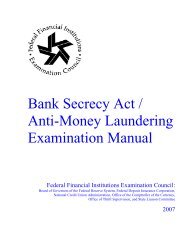Annual Report 2012 - ffiec
Annual Report 2012 - ffiec
Annual Report 2012 - ffiec
You also want an ePaper? Increase the reach of your titles
YUMPU automatically turns print PDFs into web optimized ePapers that Google loves.
maintained electronically using<br />
the FFIEC InfoBase vehicle. During<br />
the year, certain enhancements<br />
were made to the IT Handbook<br />
InfoBase, including the addition<br />
of a "What's New" function on the<br />
home page that may be used to<br />
monitor recent changes and, going<br />
forward, to access a historical listing<br />
of changes. A new “Reference<br />
Materials” section also was added.<br />
On October 31, <strong>2012</strong>, the FFIEC<br />
published an update of the Supervision<br />
of Technology Service Providers<br />
Booklet of the IT Handbook.<br />
Concurrently, the FRB, FDIC,<br />
and OCC issued new Administrative<br />
Guidelines for the Implementation<br />
of the Interagency Program for<br />
the Supervision of Technology Service<br />
Providers. The booklet contains<br />
guidance for examiners and<br />
financial institutions on the supervision<br />
of third-party technology<br />
service providers (TSPs). It also<br />
outlines the Risk-Based Examination<br />
Priority Ranking Program<br />
and includes an appendix describing<br />
the Uniform Rating System for<br />
Information Technology, which<br />
the agencies use for financial institutions<br />
and their TSPs. Although<br />
closely related to the booklet, the<br />
guidelines are not part of the IT<br />
Handbook.<br />
In response to a growing number<br />
of financial institutions outsourcing<br />
all or part of their security<br />
management function, the IT Subcommittee<br />
issued guidance entitled<br />
Managed Security Service Providers.<br />
The guidance is in the form<br />
of an appendix to the Outsourcing<br />
Technology Service Providers Booklet.<br />
The new appendix addresses<br />
the risks associated with Managed<br />
Security Service Providers engagement<br />
and offers guidance to assist<br />
institutions in mitigating the risks.<br />
On July 10, <strong>2012</strong>, the FFIEC issued<br />
guidance entitled Outsourced Cloud<br />
Computing. The FFIEC member<br />
agencies consider cloud comput-<br />
ing to be another form of outsourcing<br />
with the same basic risk<br />
characteristics and risk-management<br />
requirements as traditional<br />
forms of outsourcing. The guidance<br />
addresses key risk considerations<br />
associated with outsourced<br />
cloud computing activities and<br />
identifies applicable risk mitigation<br />
considerations contained in<br />
the various booklets that comprise<br />
the IT Handbook.<br />
BSA/AML Working Group<br />
The BSA/AML Working Group is<br />
responsible for maintaining and<br />
providing timely updates to the<br />
BSA/AML Examination Manual.<br />
The working group sponsored its<br />
sixth FFIEC Advanced BSA/AML<br />
Specialists Conference in July<br />
<strong>2012</strong>. Feedback from the conference<br />
was positive. The agencies<br />
continued to share information<br />
with the Financial Crimes Enforcement<br />
Network and with the Office<br />
of Foreign Assets Control.<br />
Task Force on<br />
Surveillance Systems<br />
The Task Force on Surveillance<br />
Systems oversees the development<br />
and implementation of uniform<br />
interagency surveillance and<br />
monitoring systems. It provides<br />
a forum for the member agencies<br />
to discuss best practices to<br />
be used in those systems and to<br />
consider the development of new<br />
financial analysis tools. The task<br />
force’s principal objective has been<br />
to develop and produce the Uniform<br />
Bank Performance <strong>Report</strong><br />
(UBPR). UBPRs present financial<br />
data and peer group statistics of<br />
individual financial institutions<br />
for current and historical periods.<br />
These reports are important<br />
tools for completing supervisory<br />
evaluations of a financial institution’s<br />
condition and performance,<br />
as well as for planning onsite<br />
examinations. The banking agencies<br />
also use the data from these<br />
reports in their automated monitoring<br />
systems to identify potential<br />
or emerging problems in insured<br />
financial institutions.<br />
A UBPR is produced for each<br />
insured bank and savings association<br />
in the United States that is<br />
supervised by the FRB, FDIC, or<br />
OCC. UBPR data are also available<br />
to all state bank supervisors. While<br />
the UBPR is principally designed<br />
to meet the examination and surveillance<br />
needs of the federal and<br />
state banking agencies, the task<br />
force also makes the UBPR available<br />
to financial institutions and<br />
the public through a public website,<br />
www.<strong>ffiec</strong>.gov/UBPR.htm.<br />
Initiatives Addressed in <strong>2012</strong><br />
Thrift Financial <strong>Report</strong> Consolidation<br />
into Call <strong>Report</strong><br />
When the Dodd-Frank Act dissolved<br />
OTS, OCC and FDIC mandated<br />
that thrift institutions formerly<br />
regulated by OTS begin<br />
filing Call <strong>Report</strong>s no later than<br />
March 31, <strong>2012</strong>. The task force<br />
determined that all thrift institutions<br />
will be placed into the existing<br />
FDIC-insured savings bank<br />
asset-based peer groups. There are<br />
currently four FDIC-insured savings<br />
bank peer groups: insured<br />
savings banks having assets less<br />
than $100 million, insured savings<br />
banks having assets between<br />
$100 million and $300 million,<br />
insured savings banks having<br />
assets between $300 million and<br />
$1 billion, and insured savings<br />
banks having assets greater than<br />
$1 billion. As of March 31, <strong>2012</strong>,<br />
thrift institutions were placed<br />
in the existing FDIC-insured savings<br />
bank asset-based peer groups.<br />
The task force agreed to create<br />
supplementary peer groups<br />
based on savings banks’ owner-<br />
17

















